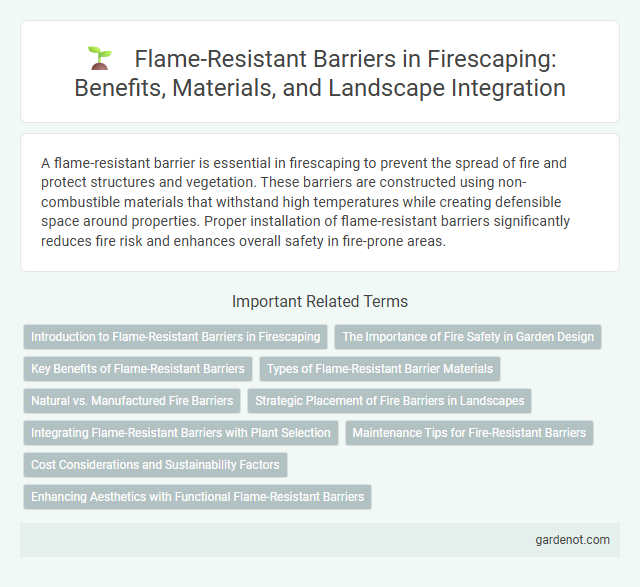A flame-resistant barrier is essential in firescaping to prevent the spread of fire and protect structures and vegetation. These barriers are constructed using non-combustible materials that withstand high temperatures while creating defensible space around properties. Proper installation of flame-resistant barriers significantly reduces fire risk and enhances overall safety in fire-prone areas.
Introduction to Flame-Resistant Barriers in Firescaping
Flame-resistant barriers are critical in firescaping to help prevent the spread of wildfires by creating defensible zones around properties. These barriers consist of fire-resistant materials such as non-combustible plants, stone paths, and gravel that reduce fuel continuity. Implementing flame-resistant barriers enhances landscape resilience and safeguards structures from ember attacks and radiant heat.
The Importance of Fire Safety in Garden Design
Flame-resistant barriers play a crucial role in firescaping by preventing the spread of wildfires and protecting garden structures and vegetation. Utilizing non-combustible materials such as stone, gravel, or fire-retardant-treated wood helps create effective zones that reduce fuel continuity and slow fire progression. Integrating these barriers within strategic garden layouts significantly enhances fire safety in residential landscapes prone to high wildfire risk.
Key Benefits of Flame-Resistant Barriers
Flame-resistant barriers provide critical protection by significantly slowing the spread of fire, reducing the risk of property damage and enhancing occupant safety. These barriers are designed to withstand high temperatures and resist combustion, ensuring structural integrity under fire exposure. Incorporating flame-resistant materials in firescaping creates effective firebreaks that help contain wildfires and prevent their advancement across landscapes.
Types of Flame-Resistant Barrier Materials
Flame-resistant barrier materials in firescaping include mineral wool, ceramic fiber, and intumescent coatings, each offering unique heat resistance and fireproofing properties. Mineral wool provides excellent thermal insulation, while ceramic fiber withstands extremely high temperatures, making them ideal for fire barriers around structures. Intumescent coatings expand when exposed to heat, creating an insulating char layer that protects surfaces from flames and heat damage.
Natural vs. Manufactured Fire Barriers
Natural fire barriers, such as rock walls, gravel paths, and drought-resistant plants, serve as effective flame-resistant zones by limiting fuel availability in firescaping designs. Manufactured fire barriers include materials like fire-resistant siding, metal flashing, and concrete patios, which provide enhanced protection by physically blocking heat and flames. Combining natural and manufactured flame-resistant barriers strategically improves overall property safety by creating multiple layers of defense against wildfires.
Strategic Placement of Fire Barriers in Landscapes
Strategic placement of flame-resistant barriers in landscape design significantly reduces wildfire risk by creating effective firebreaks around properties. Utilizing fire-resistant plants, gravel, stone walls, and non-combustible materials as barriers can slow or redirect advancing flames, providing critical protection for structures. Thoughtful positioning of these barriers near ignition sources, such as woodpiles and patios, enhances landscape resilience while maintaining aesthetic appeal.
Integrating Flame-Resistant Barriers with Plant Selection
Integrating flame-resistant barriers with strategic plant selection enhances firescaping effectiveness by reducing wildfire risks and creating defensible spaces. Flame-resistant barriers, such as gravel paths, stone walls, and fire-resistant hardscaping, interrupt fuel continuity while selecting low-flammability plants like succulents, native leafy shrubs, and deciduous trees minimizes ignition potential. Combining these elements optimizes landscape safety by lowering fire intensity and slowing flame spread near structures.
Maintenance Tips for Fire-Resistant Barriers
Regular inspections of flame-resistant barriers ensure integrity by identifying cracks, gaps, or wear that can compromise fire resistance. Cleaning surfaces with non-abrasive methods prevents the buildup of flammable debris without damaging protective coatings. Promptly repairing or replacing damaged sections maintains the barrier's effectiveness in controlling fire spread and adhering to safety regulations.
Cost Considerations and Sustainability Factors
Flame-resistant barriers often involve high upfront costs due to specialized materials like intumescent coatings or fire-resistant panels, but their durability reduces long-term maintenance expenses. Sustainable fire barriers utilize eco-friendly materials such as recycled gypsum or mineral wool that minimize environmental impact while complying with fire safety standards. Investing in fire-resistant barriers enhances property protection and contributes to sustainable building practices through reduced energy consumption and waste generation.
Enhancing Aesthetics with Functional Flame-Resistant Barriers
Flame-resistant barriers in firescaping combine safety with design, using materials that withstand high temperatures while complementing landscape aesthetics. These barriers, often made from non-combustible stone, metal, or specially treated composites, effectively prevent fire spread without disrupting visual harmony. Integrating functional flame-resistant barriers enhances outdoor spaces by balancing protective measures with elegant, natural appearances.
Flame-resistant barrier Infographic

 gardenot.com
gardenot.com